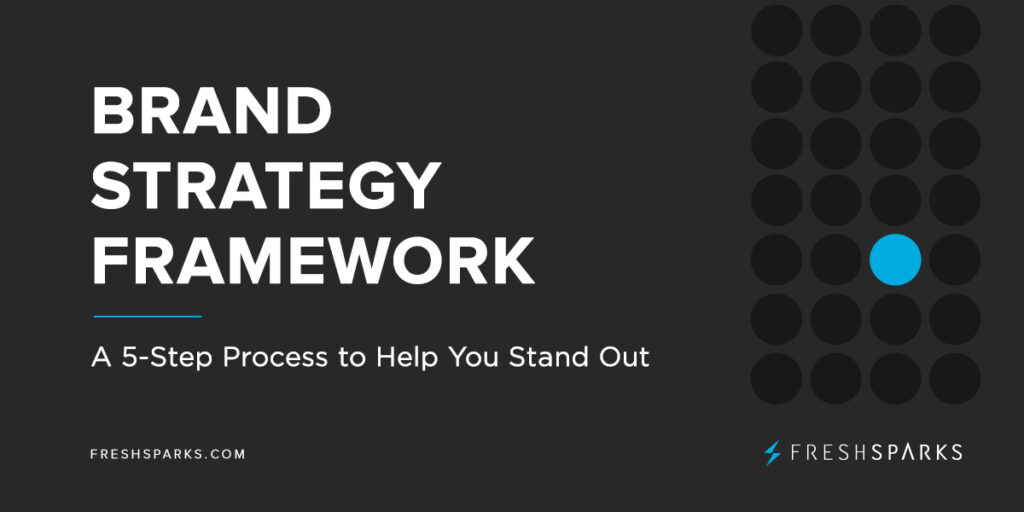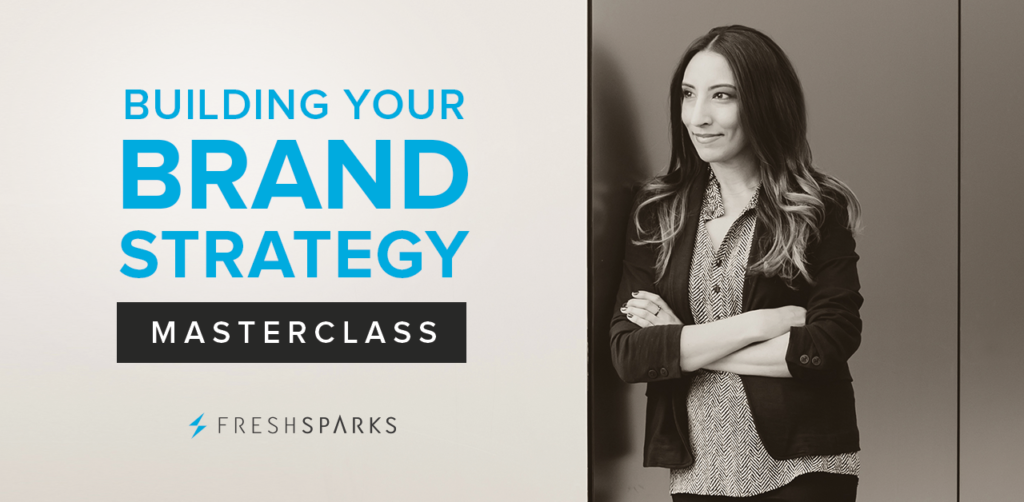
Want to ensure alignment with your business goals and future growth? Follow this proven brand strategy framework for long-term customer loyalty and employee retention.
Let’s play this or that.
💻 Apple or Microsoft?
☕ Starbucks or Dunkin’ Donuts?
🥤 Coke or Pepsi?
Surely you may have a preference for one or the other of these rival brands?
Each of them has placed their companies in the minds of particular consumers – like you and me – through their unique positioning, messaging, personality, and feeling.
You can bet these big-name brands do not go into creative meetings randomly choosing colors and graphics, or throw together marketing campaigns on a whim.
In other words, they’ve got their brand strategy on point.
These brands know how important it is to plan for the future and execute consistently.
Every decision they make has a strategic reason behind it – resulting in exponential brand growth.
Want to know more about the importance of brand strategy for your business?
I thought that’s why you’re here! In this article, I’ll be covering:
- Exactly what is brand strategy?
- Major advantages of strategic branding
- A proven 5-step brand strategy framework
BRAND STRATEGY MASTERCLASS
Learn to create a powerful blueprint that will transform your business into an extraordinary brand that stands out!

What is brand strategy?
Brand strategy is a plan that focuses on the long-term development of a purpose and emotional impact. It defines how a company differentiates from its competition in a unique way.
It’s also known as branding strategy or brand development strategy.
Many businesses skip this step because they just don’t know how to develop a brand strategy effectively.
They go straight to getting a logo designed, and throwing up a website.
The problem is that they haven’t first understood how to differentiate and communicate effectively to the right people.
Or they think that some flashy marketing will be enough to earn a customer’s trust and conversion.
(It won’t be.)
What good is it dropping thousands of marketing dollars to get people to your website when the message there doesn’t stand out, connect, or inspire them to take action?
Some organizations even focus solely on sales and bypass any emotional connection they could have with the people they are selling to.
Truth bomb:
When you are only focused on transactions or selling, you risk becoming a commodity and lose the chance for brand loyalty.
A customer will just as easily go to another business if yours hasn’t established a relationship or connection with them.
(It’s human nature.)
Your brand strategy process as a whole should fundamentally answer these questions:
- Who are you?
- What do you do?
- Why does it matter?
You see:
People these days are short on time.
They also have a lot of options.
And even more so, all those choices in products or services out there now can be very similar.
You are probably up against a competitor that has the same product features or the same services offering.
You have to differentiate.
In order to differentiate your brand, the answers to those three questions above need to be very focused.
In fact:
The answers should come from your experience and beliefs as a business owner.
The path that brought you to where you are today with your business, your reason for serving others, is completely unique to YOU and your company.
Truthfully, this is what will set you apart if you can communicate it in an authentic way.
Because you will be different from anyone else.
It’s like a fingerprint.
You want to use your unique brand strategy to shape people’s perceptions in a positive way, so that they choose to do business with you over someone else.
If you don’t shape the brand perception that you’d like people to have as they come into contact with your company, product, or service – they’re going to just make it up on their own (for better or worse)!
Enroll now: Building Your Brand Strategy Masterclass

The Advantages of Building a Brand Strategy
A well-developed brand strategy framework is a literal blueprint for shaping your brand to your consumers.
With brand strategy, you can ensure alignment with your business goals and future growth, consistency in your communication, and more predictability with your marketing efforts.
If that isn’t enough for you to go run and focus on strategic branding, here are SEVEN other big benefits you can experience:
✅ Your decision-making is focused, easier, and more accurate.
The clarity you gain from knowing who your brand is will save you time when you innovate, strategize, or execute anything in your business.
✅ The competition starts to look ordinary because you stand out as exceptional.
If you aim to be the go-to option for your ideal consumers, your brand development strategy is what will help you differentiate from the noise.
✅ A strong brand attracts people who are willing and more motivated to buy from you.
Research shows that 71% of consumers prefer buying from businesses that align with their own values. When there is a synergy in beliefs, it creates a loyal bond.
✅ Your product or service is less of a commodity and more valuable to people.
Want to eliminate convincing people to buy? Building a strategic brand means you do not have to compete on price and can acquire easier sales.
✅ You can raise your prices because you have defined your value clearly.
Similar to above, because the value is so apparent and desired, you’re able to offer your products or services at a premium.
✅ You won’t be questioning your marketing spend and the ROI from it.
With the right brand strategy, your targeting, message, and position are so dialed in that you are doing more relevant marketing and less spaghetti-against-the-wall campaigns.
✅ You cultivate a company culture that magnetizes the best talent for your team.
A cohesive brand helps employees stay engaged and interested in what they are working towards, also improving retention.
All of these advantages are a result of thinking and planning – before designing and doing. Together, they pack a punch for more impact on people and profit in your business.
You may be wondering how to develop a brand strategy – what even goes into a proven brand strategy process?
I’ll tell you.

A Step-by-step Brand Strategy Framework
When we work with clients in our brand agency or our coaching program, we follow a specific brand strategy framework – a series of proven steps.
Each of these steps contributes to the next one, and the ideal results occur when we complete them in order.
It’s just important not to skip a step when building a brand strategy!
We’ve seen this work time and time again. It’s not exclusive to any type of industry or company size. It’s not exclusive to a product or a service business.
And it’s not just for big brands! If you are selling something to humans, this process is a necessity for growth.
Here’s a straightforward brand strategy process to follow in five steps:

Step 1: Discover Your Brand Purpose
Every successful brand has a powerful purpose behind it.
If you and your employees do not have a reason for waking up every day, fueling you to provide the best solutions for your consumers and make an impact on the world – you will probably have trouble building a long-term brand.
I just have to put that out there.
And sometimes, it’s not an easy thing to document without some digging and insight into who you are.
When discovering the substance and meaning for your brand purpose, you’ll need to engage in workshops and interviews to gather insight, brainstorm, and gain clarity about your business model, long-term vision, process, and reason for being.
You want to clearly define the what, how, and why behind the brand so that your strategic direction and identity aligns with your business goals, your internal culture, and the needs of your customer.
The result of this deep work brings to the surface your:
- Purpose
- Vision
- Mission
- Values
…all in support of who your brand is to the world.
According to McKinsey, on keeping the promise behind purpose as a strategic effort:
“Finding purpose is important, but it’s not enough for brands to prosper. Purpose needs to be translated into a set of values and goals that guide communications, operations, and people and product development.”
Give people a reason to believe in you across all touchpoints, so that they feel inspired to buy from your brand – or work for your business!
READ MORE:
Brand Purpose: Find Your Why with 7 Powerful Questions
Brand Vision: How to Stop Drifting and Start Driving Growth

Step 2: Develop Your Brand Audience
The second step of this brand strategy framework is all about your specific consumer.
The people you serve are the life of your business and the better you understand them, the more you can tailor their experience with your strategic brand message and marketing tactics.
In order to develop well-informed audience profiles and buyer personas, you’ll need to explore some or all of the following:
- Existing customer data
- Voice of customer research
- Focus groups
- Surveys & questionnaires
- Social listening
- Customer interviews
From all the research and data gathered, you’ll be able to paint a picture of your ideal consumers through a combination of:
- Demographics (real, statistical data)
- Psychographics (speculated behaviors, motivations, concerns)
Defining the exact people you want to be speaking to, will ensure that your brand communication comes across clearly and in a way that resonates.
You do not want to be everything to everyone, with the same old message that everyone has.
Hone in on the audience that can benefit the most from your offer, and aligns with your brand values and beliefs.

Step 3: Conduct Competitor Research
In order to stand out from the noise in a distinct way, you have to know who your brand is up against on a direct and indirect level.
Competitor research helps you understand where your position should be in the market.
Please (please!) do not open up the website of a rival brand, check them out for a few minutes, and call it a day.
Effective research includes an in-depth analysis of competitors or benchmark brands to identify gaps, areas of opportunity, and key differentiators for brand positioning.
How deep or wide you want to go with your research depends on:
…the amount of competition in your industry or market.
…the time you or your team can spend on it.
…how much you really need to differentiate.
The goal of this step in the brand strategy framework is to claim the space you want to own in the market and the minds of your customers.
You can research and analyze these things:
- Brand message
- Visual identity
- Website user experience
- Search engine optimization
- Blog content
- Social media engagement
Knowing where the competitors stand will give you an understanding of your edge and advantage.
And because you’ve done the work to develop your audience already (step 2), you can define the one big differentiator that matters to them.
All it takes is one big idea to capture their attention.
You’ll be able to create your USP (unique selling proposition), value propositions, and brand positioning statement from what you discovered in your competitor research and analysis.

Step 4: Define Your Brand Voice
People seek authentic brands with clear communication supported by a voice that resonates with them, speaks to them, and that they understand.
How do you address your audience in the right way?
Your content has to tell a story (see step 5) in order to make an impact…it needs to be communicated consistently and with a humanized element behind it.
Brand voice is your style, point of view, and personality. It’s used throughout all modes of communication – written, video, and audio.
It’s not what you say, but HOW you say it.
One method of developing brand voice characteristics is to explore and align with a brand archetype.
(Many big brands do this – Harley Davidson is a prime example of the Outlaw).
Archetypes were introduced by Swiss psychiatrist Carl Jung, and later adapted for branding by a business consultant, Carol Pearson.
Brand archetypes embody universal human values. They are relatable because we see ourselves in them.
Each archetype embodies an innate desire that humans crave.
There are 12 brand archetypes to choose from:
- Hero (Mastery)
- Magician (Power)
- Explorer (Freedom)
- Sage (Understanding)
- Innocent (Safety)
- Creator (Innovation)
- Ruler (Control)
- Caregiver (Service)
- Everyperson (Belonging)
- Jester (Pleasure)
- Lover (Intimacy)
Explore these archetypes further to see if one or more align with your brand. What core desire do you feel your ideal buyer has?
Don’t make the mistake of taking on too many archetypes. This can muddle your personality and may not have the strongest effect on attracting the right people.
Choose 2 (or 3 max) to create your brand archetype mix. Even better – choose one as the primary archetype, and another to support it.
Since each archetype has unique characteristics, create your brand voice guidelines based on the personality combination you develop.

Step 5: Create a Brand Message and Story
You might already know this:
A brand is a customer’s perception of your business – how THEY experience it, and how they FEEL about it.
Feelings and emotions can play a big part in the way that people perceive you and trust you.
(We see that on a daily basis in our personal lives, right? It’s actually not much different with business.)
Every interaction a person has with your brand tells a story and sends an emotional message that can resonate favorably, OR it can completely turn you off.
If it happens to be too logical and void of emotion – you’ll miss the mark (and likely the conversion).
It’s critical to develop a core message and framework to support all your brand messaging and communication.
Your business needs a clear and impactful brand message that captures the hearts and minds of your customers.
The brand message and storytelling create a connection between your business and the consumer.
This connection can last years (if not decades, in the case of a brand like Coca-Cola).
Your storytelling will weave throughout everything you create for your brand.
One of the most impactful stories you can share is your brand origin story.
Create an origin story by following this flow:
- How did your business start?
- Where is the business now?
- Where do you want to go in the future?
There you have a proven five-step framework to follow when developing a brand strategy.
What next?
If you want to be personally walked through this entire brand development strategy process with action items, a comprehensive workbook, and lots of examples for inspiration, enroll in the Building Your Brand Strategy Masterclass.

Conclusion: Stand Out with Brand Strategy
Branding is a marathon, not a sprint.
Building a strong brand happens over time, but requires a comprehensive brand strategy for long-term success.
Without a strategic direction and branding plan, you can start to feel disjointed, inconsistent, and all over the place.
However, once you know what it really means to become a brand, your mindset about business changes.
…You’ll look at lead generation, marketing, and sales differently.
…Your products, services, and delivery will be more customer-focused.
…Marketing efforts will be more strategic and have a higher ROI.
…You experience faster growth and acquire more market share.
Your brand strategy will map out how you are different, trustworthy, memorable, and likable by your ideal customer. It will convey your purpose, promises, and how you solve problems for people.
To get started, follow this effective brand strategy framework:
- Discover your brand purpose
- Develop the target audience
- Conduct competitor research
- Define your brand voice
- Create a brand message and story
What questions do you have about building a brand strategy for your business?
Share in the comments below!
(If you liked this article, please share it!)
FreshSparks is a branding agency specializing in brand strategy, brand identity, and brand marketing. We can help you excel with your positioning, point of view, and presentation to make an impact on the right people from awareness to conversion to retention. It’s the perfect mix of building a long-term brand with purpose so that you can make a profit.
Book a consultation to learn more.


Thank you Sonia for an interesting article. This is useful information for me.
Thanks for such an informative guide. It’s a very Useful and well-written article.